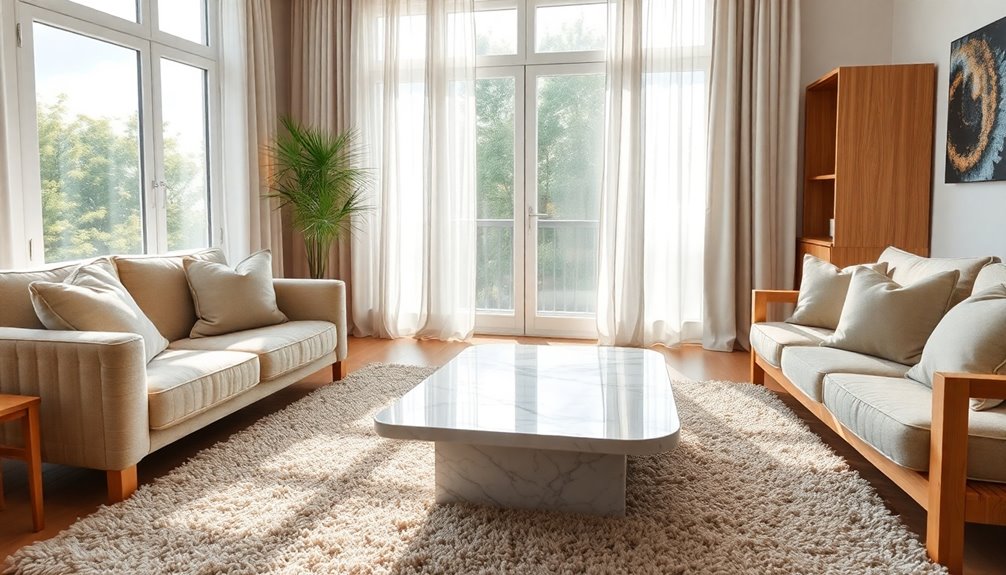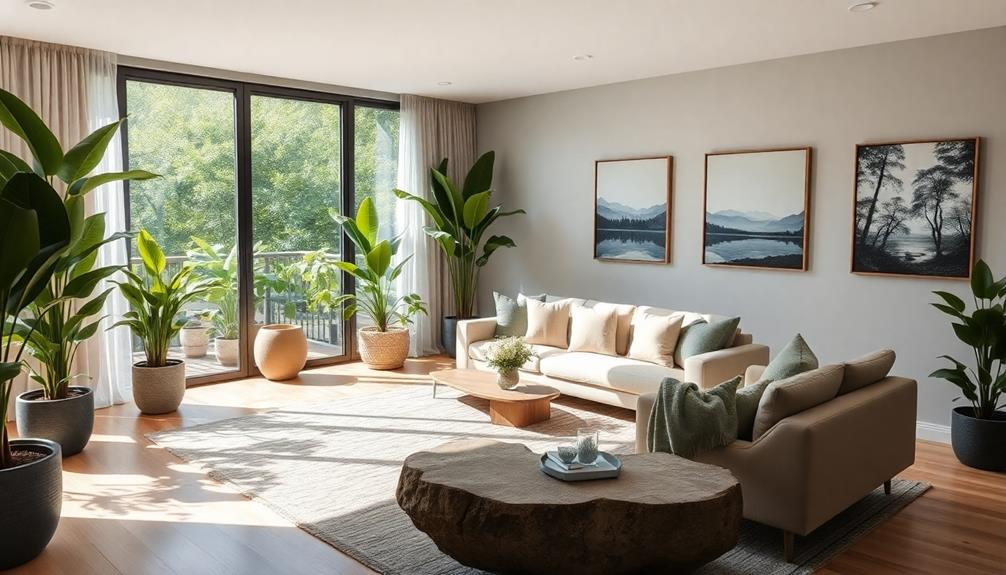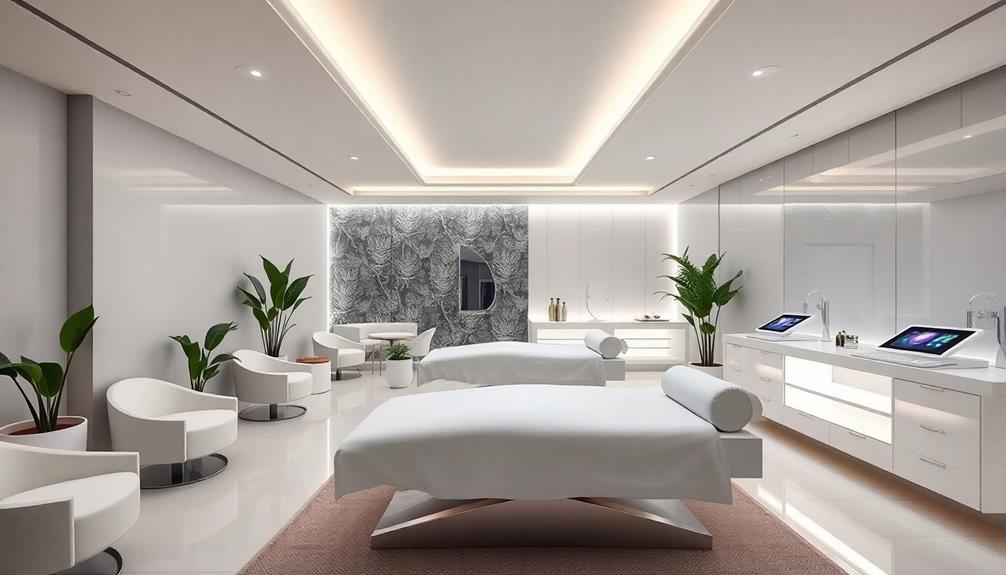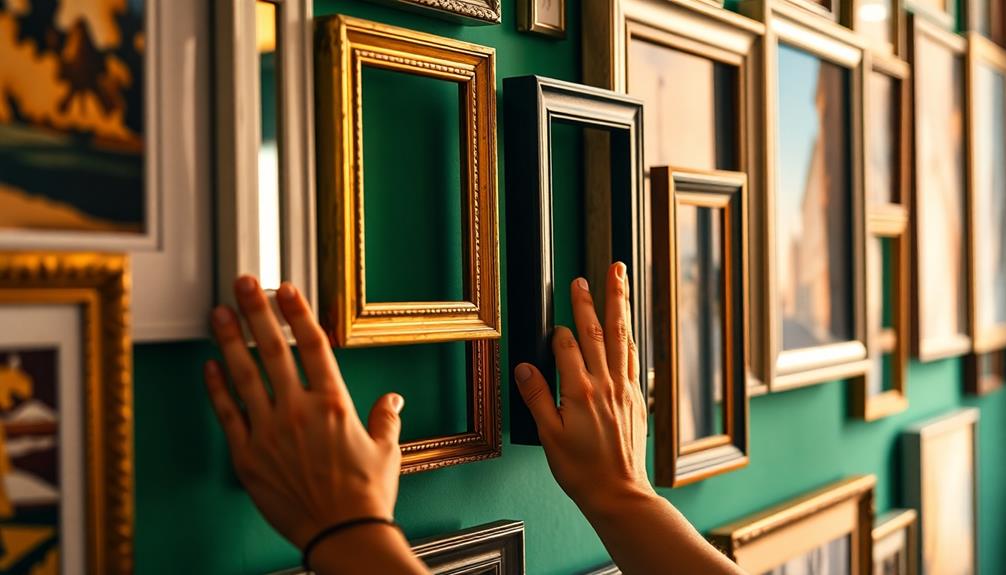Texture considerably impacts your interior space by influencing its look and feel. It shapes mood, adds depth, and prevents monotony using a mix of soft and hard materials. By integrating various textures, like natural elements or polished finishes, you enhance sensory experiences and emotional responses. Remember, light interacts uniquely with different textures, affecting ambiance and color perception. If you explore further, you’ll discover practical ways to incorporate texture effectively in your designs.
Key Takeaways
- Texture shapes the ambiance of a space, influencing both visual appeal and tactile experiences in interior design.
- Combining various textures, like soft and hard materials, enhances depth, interest, and emotional responses within a room.
- Natural and polished textures can evoke different moods, from coziness to sophistication, reinforcing the overall design narrative.
- The interaction of light and texture affects color perception and ambiance, creating warmth or brightness in a space.
- Textures also play a role in maintenance, durability, and acoustics, impacting the functionality and longevity of interior designs.
The Definition and Importance of Texture
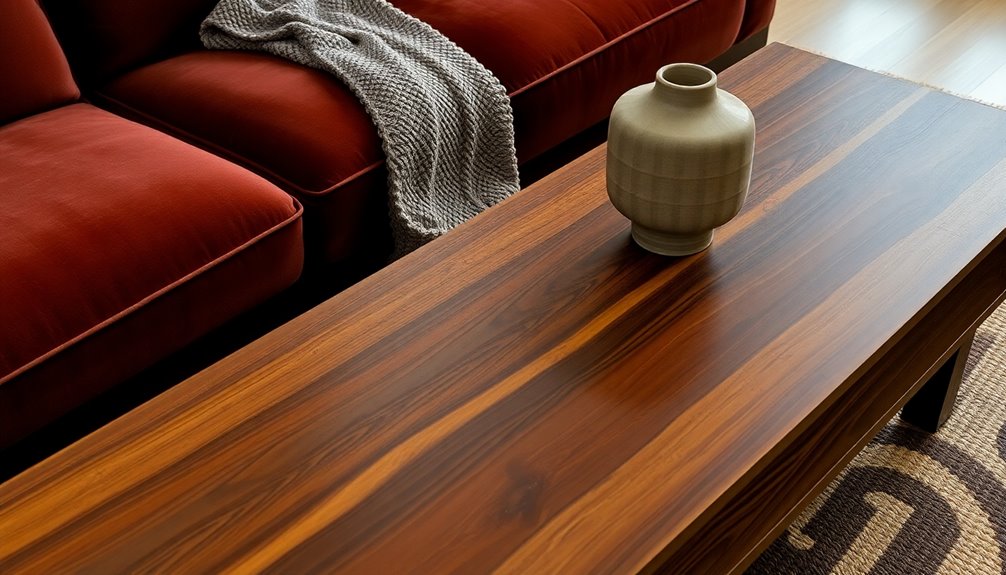
When you think about interior design, texture often gets overlooked, yet it’s a vital element that shapes how a space feels and looks.
Texture refers to the physical or visual surface quality of materials, influencing both visual and tactile experiences. It plays an essential role in conveying mood and style; soft textures can create a cozy atmosphere, while hard textures add sophistication.
By incorporating varying textures, you can add depth and interest to your interiors, preventing monotony. This interplay of tactile and visual textures fosters a multi-sensory experience, enhancing comfort and welcome.
When you thoughtfully select materials and finishes, you reinforce other design elements, crafting a cohesive and engaging narrative that elevates your interior design. Additionally, using natural materials like wood and stone can significantly enhance the overall texture of a farmhouse-inspired space.
Exploring Different Types of Texture
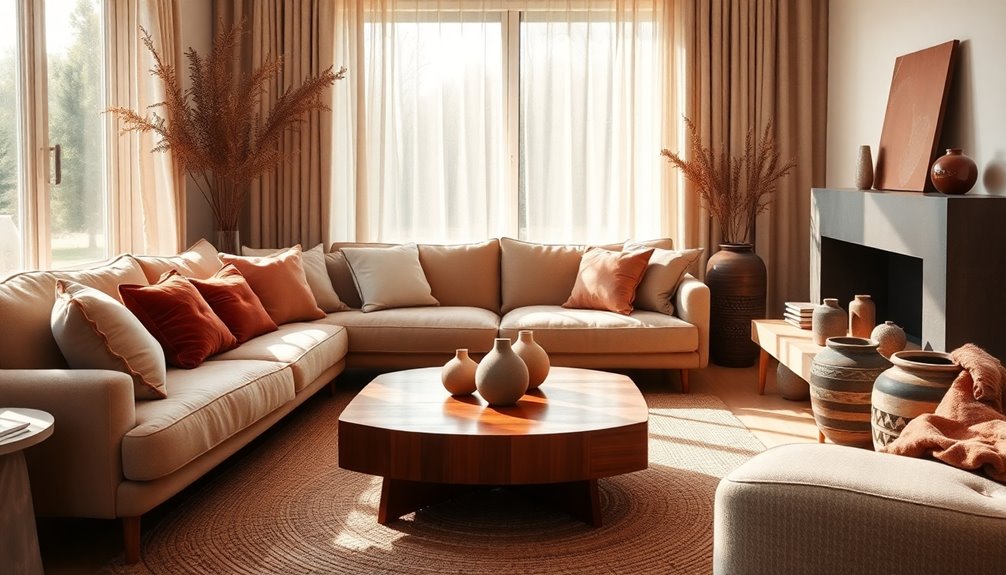
Texture plays an essential role in interior design, and understanding its different types can transform a space.
Tactile textures, like smooth, soft, or coarse surfaces, evoke varied sensations that enhance your sensory experience. Visual textures, created through patterns and finishes, offer depth and layering, mimicking materials like glazed porcelain tiles that resemble metal.
Incorporating natural textures, such as wood and stone, brings an organic feel, while polished and metallic textures add sophistication. You can elevate your design by layering different textures, such as soft fabrics paired with hard surfaces, to maintain visual interest and prevent monotony. Additionally, considering budgeting techniques can help ensure that your texture choices align with your overall financial plan.
Ultimately, choosing the right textures can greatly influence how a space feels, whether warm and inviting or modern and sleek.
The Role of Texture in Creating Emotional Responses

When you think about texture in interior design, consider how soft and hard surfaces affect your feelings.
Mixing different textures can create a balanced atmosphere, influencing your mood in subtle yet powerful ways. Incorporating soft textiles like throws and cushions can enhance the cozy feel of a space, making it more inviting.
Soft vs. Hard Textures
In interior design, the choice between soft and hard textures can dramatically shape the emotional landscape of a space.
Soft textures, like velvet and cotton, create an inviting atmosphere, evoking warmth and comfort that encourages relaxation. On the other hand, hard textures such as polished granite or concrete impart sophistication and modernity, often lending a more formal feel to the room.
The emotional response to these textures considerably influences how you perceive and interact with your environment. By employing contrasting textures, you enhance visual interest, layering a room with depth.
A balanced mix of soft and hard textures crafts a dynamic experience, where the softness adds comfort while the hardness provides structure and elegance, creating a harmonious and engaging space. Additionally, incorporating lighting design can further amplify the emotional effects of these textures, enhancing the overall ambiance of the room.
Mixing Textures for Balance
Creating a balanced environment often hinges on the careful mixing of textures, as this interplay can greatly influence your emotional experience in a space. By mixing different textures, like soft fabrics with rough wood, you can create a cozy, inviting atmosphere. Glossy tiles paired with matte fabrics enhance the overall look, adding layers of tactile and visual interest.
| Texture Type | Emotional Response |
|---|---|
| Soft Fabrics | Comfort and Warmth |
| Rough Surfaces | Earthy and Grounding |
| Glossy Finishes | Luxury and Sophistication |
Incorporating both natural and synthetic textures guarantees your design feels personalized, shaping an ambiance that resonates with your tastes while inviting emotional connections. Additionally, understanding the importance of diversification in your design choices can lead to a more harmonious and engaging space.
Texture’s Influence on Mood
Texture plays an essential role in shaping the mood of a space, as the right combination can evoke distinct emotional responses.
Soft textures, like velvet and chenille, create a sense of comfort and luxury, enhancing relaxation. In contrast, hard textures such as polished granite and metal introduce sophistication and elegance.
Mixing various textures crafts a balanced emotional experience; for instance, rough tumbled stone adds warmth alongside sleek finishes. The interaction of texture with light also influences mood—smooth surfaces reflect light for a bright feel, while coarse textures absorb it, fostering intimacy. Additionally, user experience is significantly influenced by the careful selection of textures, enhancing overall engagement in interior design.
Layering Textures for Depth and Dimension
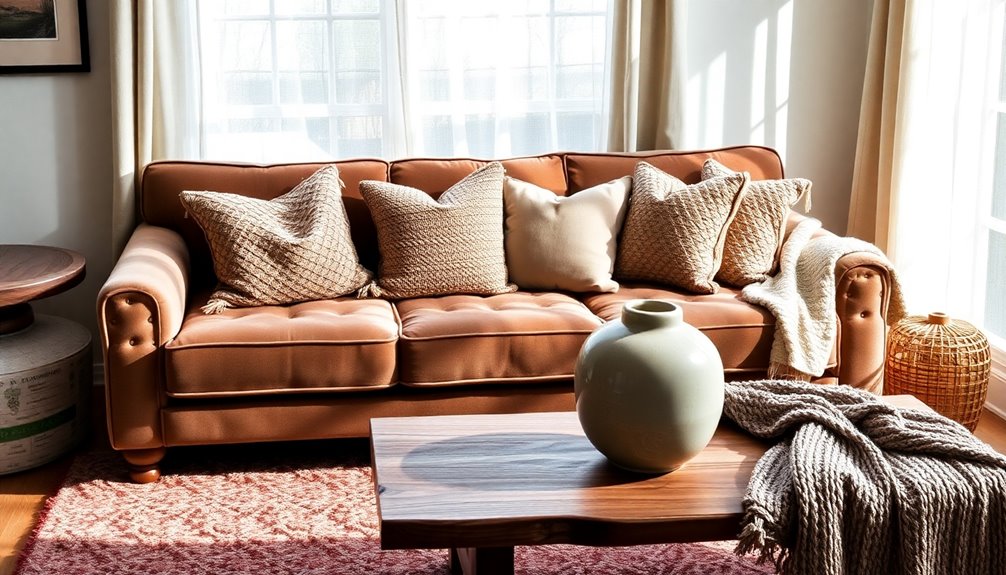
While you might think of interior design as just colors and furniture, layering textures brings a whole new level of depth and dimension to your space. By incorporating contrasting materials, like plush rugs beneath sleek furniture, you create a multi-dimensional effect that enhances visual interest.
This thoughtful layering of textures not only adds depth and character but also distinguishes areas in open-plan layouts. Imagine mixing tactile textures such as velvet cushions, linen curtains, and woolen throws; these elements work together to form engaging spaces that invite exploration.
Effective layering can evoke various moods, making your room feel dynamic and inviting. Embrace the richness textures bring to your design, transforming your interior into a warm, inviting sanctuary. Additionally, consider incorporating exposed beams into your design, as they add rustic charm and character that complements layered textures beautifully.
The Interaction of Texture and Light
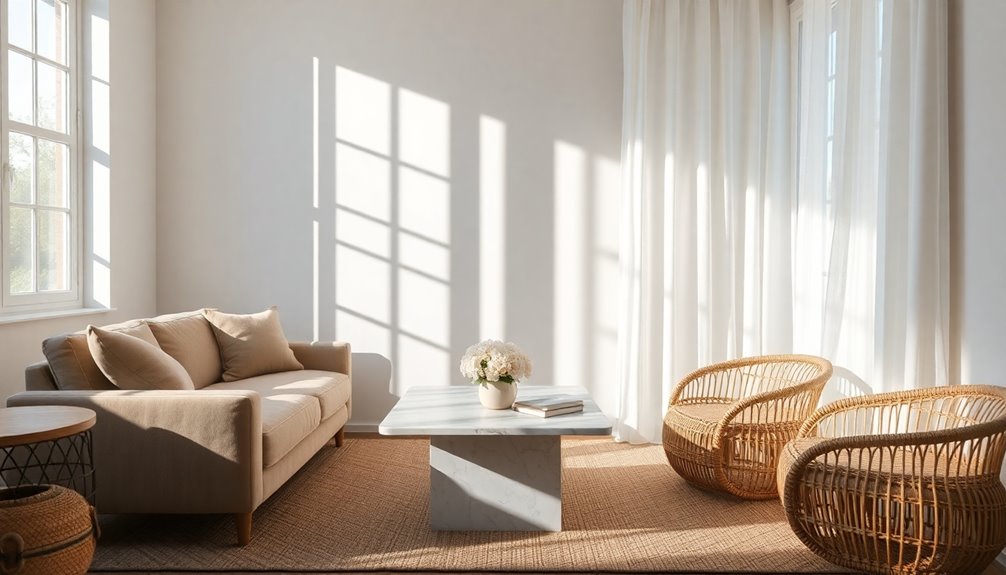
When you consider how light interacts with your interior design, you’ll find that the textures in your space play an essential role in shaping its ambiance.
Smooth surfaces, like polished granite, reflect strong lighting, brightening a room and enhancing visual weight. In contrast, coarse textures absorb light, creating a warmer, more intimate atmosphere.
This interplay can greatly affect color perception; glossy finishes make hues appear vibrant, while matte textures can dull them.
When you use diffuse light, it softens the appearance of textures, minimizing imperfections and fostering a serene environment. The choice of butter color in design elements can evoke different feelings and set the mood of the space.
Practical Considerations for Texture in Design
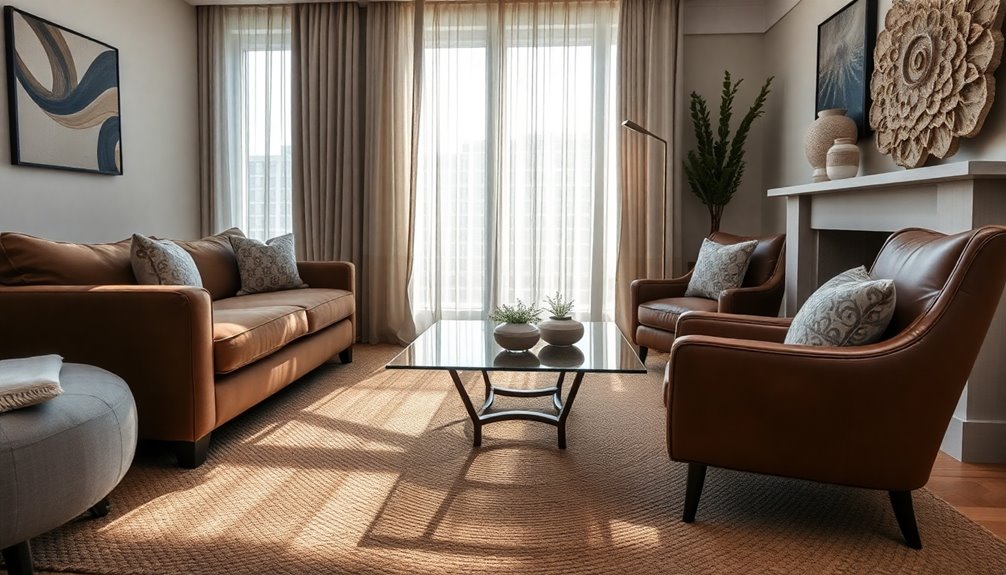
When choosing textures for your space, it’s crucial to think about maintenance and durability. Consider how different textures will absorb sound and how their scale affects the overall look. Additionally, the use of textured fabrics can add warmth and comfort to your design.
Maintenance and Durability Factors
Understanding the maintenance and durability of textures in interior design is essential for ensuring their long-term appeal and functionality. Different textures demand different levels of maintenance; smooth surfaces are easier to clean but show dust more, while rough textures may trap dirt but hide it better.
The durability of materials plays a significant role; for high-traffic areas, choose hard-wearing options like leather or treated wood to withstand wear. When selecting textures, consider stain resistance and moisture tolerance, especially for outdoor fabrics. Additionally, incorporating maintenance routines for heating pads can further enhance the longevity of textiles in spaces that require warmth and comfort.
Regular maintenance routines, such as vacuuming textured rugs and cleaning wall finishes, are important. By prioritizing durability and proper cleaning, you can enjoy beautiful textures that remain functional over time, enhancing your interior space.
Acoustic Properties of Textures
Texture plays an essential role not just in aesthetics but also in shaping a room’s acoustics. The right textures in interior design can greatly enhance sound absorption, creating a quieter atmosphere.
Soft textiles, such as carpets and acoustic panels, effectively minimize noise transmission, making them perfect for spaces like home theaters. In contrast, hard surfaces like glass and polished concrete reflect sound, which can increase noise levels and discomfort.
Choosing materials with better acoustic properties can also boost privacy, as they prevent sound leakage between rooms. By incorporating a variety of textures, you not only enrich the visual appeal of your space but also foster a more controlled acoustic environment, ensuring a serene and functional living area.
Scale and Proportion Considerations
Scale and proportion are essential elements in interior design that can make or break the overall aesthetic of a space. When selecting textures, confirm their scale corresponds with the room’s dimensions; larger patterns can overwhelm smaller areas, while smaller ones may get lost in spacious areas.
Mixing both large and small textures fosters visual interest while keeping the design harmonious. In expansive rooms, strategically layering textures can create a more intimate and inviting atmosphere.
Conversely, in smaller spaces, use textures sparingly to avoid a cluttered feel. Balancing the proportion of textured elements helps maintain a cohesive look, reinforcing the desired mood or style, and ultimately enhancing the beauty of your interior design.
Strategies for Incorporating Texture Into Your Space
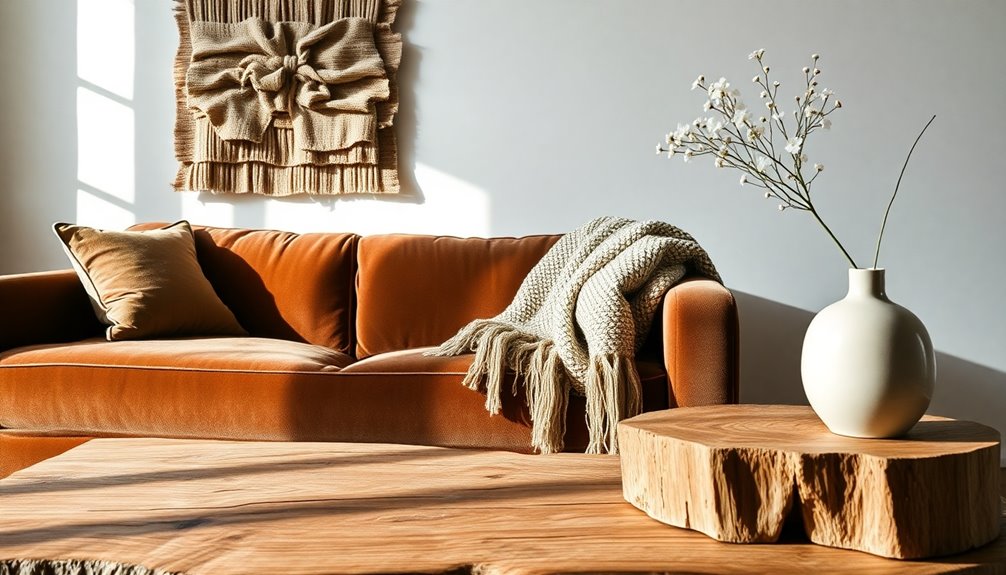
While creating a visually engaging space, incorporating various textures can make all the difference.
Start by layering different textiles, like rugs, curtains, and cushions, to create warmth and enhance comfort. Mix materials such as wood, metal, and fabric to introduce diverse textures that foster a balanced emotional experience.
Don’t shy away from using contrasting textures; combining smooth surfaces with rough ones can add visual interest and prevent monotony.
Pay attention to the scale of the textures; larger patterns might overwhelm smaller rooms, while subtle textures add depth without clutter.
Finally, utilize artwork and decorative accessories to introduce new textures, enriching your space’s overall aesthetic and allowing for personal expression in your design.
Frequently Asked Questions
What Is the Impact of Texture?
The impact of texture is profound in any environment. It affects how you perceive comfort and luxury versus sophistication and modernity.
You’ll notice how different textures interact with light, either emphasizing details or softening appearances. Layering various textures creates depth, making your space more dynamic and inviting.
Balancing rough and soft materials prevents monotony and enhances visual appeal, while also influencing acoustic properties, making your surroundings feel more functional and harmonious.
Why Are Textures Important in Design?
Textures are important in design because they add depth and character to your spaces.
When you mix various textures, you create visual interest that keeps the eye engaged. Soft textures can make a room feel cozy, while harder surfaces can lend sophistication.
What Benefit Can Texture Bring to a Design?
You might think textures are just decorative fluff, but they actually pack a punch in design. By incorporating different textures, you create a dynamic space that keeps people engaged.
Soft fabrics offer comfort, while sleek surfaces bring sophistication. Plus, layering textures helps define areas in open spaces, making them feel cozier and more inviting.
What Effect Do Lots of Textures Create in a Room?
Lots of textures in a room create a dynamic and engaging environment.
You’ll notice how different textures interact, adding depth and interest to your space. This variety prevents flatness and keeps the atmosphere lively.
Mixing soft fabrics with sleek surfaces can evoke both comfort and sophistication. Plus, contrasting textures invite tactile exploration, encouraging you to interact with your surroundings.
Conclusion
Incorporating texture into your interior design is like adding spices to a dish; it elevates the overall experience. By understanding how different textures interact with light and evoke emotions, you can create a space that truly resonates with you. Don’t be afraid to layer various textures to add depth and warmth. Remember, the right texture can transform a room from ordinary to extraordinary, making it a place where you feel at home.
